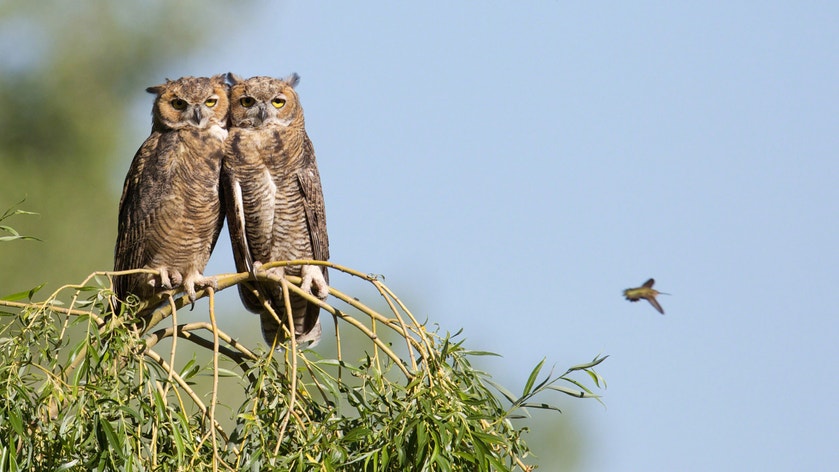Great Horned Owl
At a Glance
Found almost throughout North America and much of South America is this big owl. Aggressive and powerful in its hunting (sometimes known by nicknames such as 'tiger owl'), the Great Horned Owl takes prey as varied as rabbits, hawks, snakes, and even skunks, and will even attack porcupines, often with fatal results for both prey and predator. Great Horned Owls begin nesting very early in the north, and their deep hoots may be heard rolling across the forest on mid-winter nights.
All bird guide text and rangemaps adapted from by Kenn Kaufman© 1996, used by permission of Houghton Mifflin Harcourt Publishing Company. All rights reserved.
Category
Owls
IUCN Status
Least Concern
Habitat
Coasts and Shorelines, Desert and Arid Habitats, Fields, Meadows, and Grasslands, Forests and Woodlands, Freshwater Wetlands, High Mountains, Shrublands, Savannas, and Thickets, Tundra and Boreal Habitats, Urban and Suburban Habitats
Region
Alaska and The North, California, Eastern Canada, Florida, Great Lakes, Mid Atlantic, New England, Northwest, Plains, Rocky Mountains, Southeast, Southwest, Texas, Western Canada
Behavior
Direct Flight
Population
5.700.000
Range & Identification
Migration & Range Maps
No regular migration, but individuals may wander long distances in fall and winter, some of them moving southward.
Description
Both sexes; female larger. Length: 18-24 in (46-63 cm); wingspan: 3 ft 4 in–4 ft 9 in (1.02–1.45 m); weight: 32-88 oz (910 g–2.5 kg). The Great Horned Owl has a large size, conspicuous "ear" tufts, a white throat, and horizontal bars on the belly. Compare to smaller Long-eared Owl. Downy young (like those of other owls) are whitish at first.
Size
About the size of a Heron, About the size of a Mallard or Herring Gull
Color
Black, Brown, Gray, Orange, Reddish Brown, Yellow, Red
Wing Shape
Broad, Rounded, Short
Tail Shape
Rounded, Short, Square-tipped
Songs and Calls
Series of low, sonorous, far-carrying hoots, hoo, hoo-hoo, hoo, hoo, with second and third notes shorter than the others.
Call Pattern
Simple
Call Type
Hoot
Habitat
Forests, woodlots, streamsides, open country. The Great Horned Owl is found in practically all habitats in North America, from swamps to deserts to northern coniferous forests near treeline. In breeding season, the Great Horned Owl avoids tundra and unbroken grassland, since it requires some trees or heavy brush for cover.
Sign up for ÔĽĹÚĘÓƵ's newsletter to learn more about birds like the Great Horned Owl
Behavior
Eggs
2-3, sometimes 1-5, rarely 6. Dull whitish. Incubation mostly by female, 28-35 days.
Young
Both parents take part in providing food for young owls. Young may leave nest and climb on nearby branches at 5 weeks, can fly at about 9-10 weeks; tended and fed by parents for up to several months.
Feeding Behavior
The Great Horned Owl hunts mostly at night, sometimes at dusk. Watches from a high perch, then swoops down to capture prey in its talons. Has extremely good hearing and good vision in low light conditions. In the north in winter, may store uneaten prey, coming back later to thaw out frozen carcass by "incubating" it.
Diet
Varied, mostly mammals and birds. Mammals make up the majority of the Great Horned Owl diet in most regions. Takes many rats, mice, and rabbits, also ground squirrels, opossums, skunks, many others. Eats some birds (especially in the north), up to the size of geese, ducks, hawks, and smaller owls. Also eats snakes, lizards, frogs, insects, scorpions, and rarely fish.
Nesting
May begin nesting very early in north (late winter), possibly so that young will have time to learn hunting skills before next winter begins. In courtship, male performs display flight, also feeds female. Nest: Typically uses old nest of other large bird, such as hawk, eagle, crow, heron, usually 20-60' above ground; also may nest on cliff ledge, in cave, in broken-off tree stump, sometimes on ground. Adds little or no nest material, aside from feathers at times.
Conservation
Conservation Status
Widespread and common, Great Horned Owl numbers apparently holding up well in most areas.
Climate Threats Facing the Great Horned Owl
Choose a temperature scenario below to see which threats will affect this species as warming increases. The same climate change-driven threats that put birds at risk will affect other wildlife and people, too.











